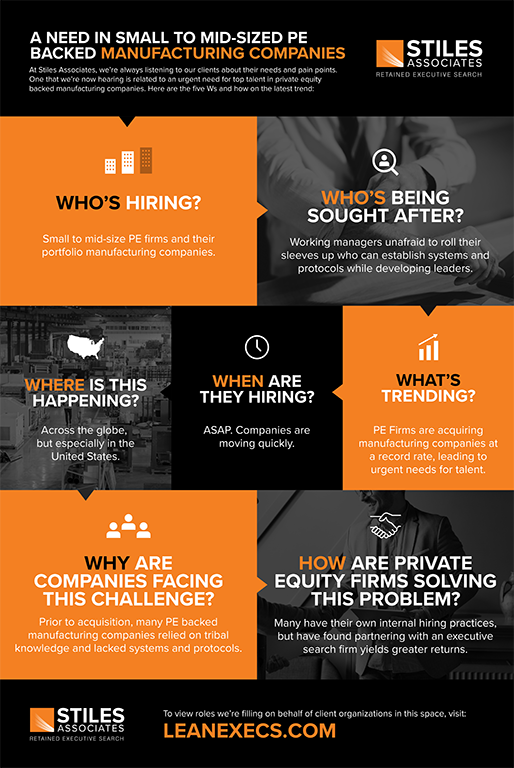Having the right manufacturing leadership in place has never been more important. Today’s manufacturers across the spectrum have doubled down on their efforts to recruit and retain top talent while simultaneously exploring ways to boost productivity, reduce waste and add value to customers.
We created this guide to share the latest insights and resources in the manufacturing leadership sector – and ultimately help your company build the roster it needs to succeed.
Table of Contents
1) Traits & Practices of Top Mfg. Leaders
2) Benefits of Transformation Leadership
3) Salary Data for Mfg. Leaders
4) Tips to Recruit and Retain Top Talent
5) Overcome Relocation Challenges
6) How to Improve Your Hiring Process
7) A Need in PE Backed Manufacturers
Traits and Practices of Top Manufacturing Leaders

As companies evaluate their current manufacturing leaders or candidates to bring in from the outside, there are several core traits the best ones share that hiring managers and senior leaders should understand.
In an increasingly global manufacturing economy with plenty of low-cost labor options, organizations that continue to manufacture in the United States need to be very, very good at it. While this is achieved with the coordination of highly effective functional leaders across the organization, the Manufacturing Operations Leader is one of the most critical components of this team. They set the vision, culture and expectations for how things will run out on the floor or across multiple plants in the case of multi-site leaders.
To do this, today’s operations leaders are very different than their predecessors from 20 years ago. Here's why:
They develop leaders
Antiquated American management culture has often heralded the achievement of the individual. While this widely led to the promotion of leaders who “got things done” by any means, it eroded the organization’s ability to develop highly engaged, learning work teams. It also often reinforced command and control work cultures where teams felt immobilized and disconnected from the organizational goals.
While great operations leaders might know how to do everything, they also keenly understand the importance of developing their people. This is a fundamental shift in how an operations leader views their job. For today’s top leaders, the main objective is to develop the capability of their teams. They have a constant focus on upgrading the skill level of their teams and have demonstrable track records establishing resilient and coordinated manufacturing cultures.
They understand that developing their team to handle the bulk of the day-to-day tasks pays much higher dividends. This might prove challenging for leaders new to an organization, so they often spend time observing the team around them and live out on the floor to establish connection and build trust.
Taking weeks or months to develop a deeper understanding of their teams and surroundings gives leaders the opportunity to identify the three types of players:
- A-players: Ensure they’re ready to move up when the time is right.
- B-players: Put them on a meaningful improvement path or reshuffling their roles and / or responsibilities to play to their strengths and gain confidence.
- C-players: Reassign them to roles that are mutually beneficial.
Identifying those players helps set up senior management for long-term quantitative and qualitative success. Good operations leaders can rattle off the operational metrics they’ve improved upon, and while great ones can do the same, they also show how much of their direct reporting team has been promoted up the company ladder.
This is the single-most requested trait our clients seek when hiring manufacturing operations leaders.
They understand servant leader leadership
Another big step in the evolution of the operations leader has been turning the traditional leadership model upside down. In the servant leadership model, leaders work for the individuals on the floor, even though they are not above them in the org chart. They view their responsibilities as listening to the needs of those on the front line and removing all obstacles.
This, of course, is easier said than done. If you consider the path of any leader, they often arrive at that position by working relentlessly and having all the answers, so breaking decades of habits is required to change the mindset. As our clients now look at leadership styles a little differently, gone are the days of driving performance through fear, and in are the days of positively reinforcing direct reports that the leaders work for them.
They create a visual factory
There is a tactical best-in-class method to making things understandable and visible on the floor. This is not only for the benefit of the hourly associates, but for the supervisors, managers and directors as well. There has also been a huge cultural shift in the willingness to manage this way. Instead of keeping critical information about performance rates and organizational goal metrics closely held, world-class operations leaders create a connected management system. The top organizational goals are openly shared as are the critical KPIs. This information cascades through the organization down to the floor level and monitored daily if not hourly.
Even today, there are still manufacturing plants that give the gameplans to managers and let them call the plays with minimal input from the floor. The new and innovative class of manufacturing leaders are using a different approach of driving engagement by being transparent; sharing the big picture with the team makes everyone more connected, efficient and effective at their jobs.
They make problems a good thing
It sounds cliché, but problems are truly opportunities. Today’s leaders know this and know how to create cultures where workers are encouraged to bring forward problems for three reasons: (1) they know it will help them run their zones better; (2) they’ll have input on how to fix it; (3) they not only won’t get reprimanded, they might get rewarded.
If they have an office, they rarely use it
We hear this every day from our clients: “We need someone out on the floor with the people.”
Top operations leaders instinctively like to be out on the floor. They know they can’t make critical decisions without understanding the floor realities as it pertains to people, process and infrastructure. The benefits are massive, and it’s core to their ability to building trust and rapport with the organization.
How Companies Benefit from Transformation Leadership

Creating a culture of continuous improvement can be difficult to implement, and further obscured by a high rate of variability in how it's executed. However, there are a few things to keep in mind when considering whether or not hunting for transformation leaders is right for your company.
First, the best manufacturing companies primarily focus on process, not outcomes. The general belief is if an organization deeply focuses on creating customer value, then relentlessly improves the processes that delivers it, the results will come (financial, growth, etc.).
Additionally, these organizations understand that pursuing operational performance is a never-ending endeavor. It takes constant focus, effort and most importantly, leadership support. The best organizations in the world understand this is not something they do in addition to running their business, this is how they run the business.
When companies focus on people and process, they can expect these results:
Maximized productivity
-
Shorter lead times
-
More inventory turns
-
Less rework
-
Better workflows and processes allow organizations to absorb more demand without increasing headcount
-
Identifying, addressing and eliminating mistakes early in the cycle prevent additional inventory and higher labor costs down the line
A continuously improving organization
- Constant focus on improvement drives regular changes in performance
- Leaders hold frequent training sessions and kaizen events to enhance their workers’ skills and knowledge
- Always looking for new opportunities to deliver more value to customers; and always evaluating the process and product creates possibilities that weren’t previously there
Higher rates of employee engagement and satisfaction
- Lower rates of turnover
- Increased accountability on the floor
- Leaders encourage employees to make problems visible and use those opportunities to improve
- Developing people creates upward career mobility and bench strength
- Higher levels of trust and respect
Improved financials
- Lower levels of raw materials and finished goods inventory kept on hand
- A better and faster process allows manufacturers to build on demand instead of relying on sales forecasts
- Improved margins
Higher rates of growth and customer loyalty
- Higher quality product
- Outperform the competition on service, quality and value
- Companies that prioritize having transformation leadership traditionally win share based on elements other than price, as competitors might be more affordable but provide lesser value
Salary Data for Manufacturing Leaders
The Stiles Associates team continues to place a number of A-level leaders in mission-critical roles located across the country. Each quarter, we share key information from a handful of those searches — which both hiring authorities and candidates alike will find beneficial to grasp a better understanding of the marketplace demands in several sectors.
The following data points stemming from these searches include: job title, client info, where the candidate was placed and first-year salary plus bonus, sign-on and equity / LTIP.
View the 2025 Q3 Compensation Report
Quick Tips to Recruit and Retain Top Talent

Senior leaders have long spent their careers handling their business a certain way, so not only acknowledging, but immediately updating the following areas will result in significant improvement in recruiting and retaining A-talent:
Compensation
- Don't expect a "hometown discount" simply because they've been loyal employees
- Equity in the company and performance bonuses go a long way
- We’ve seen candidates willing to sacrifice up to 30 percent of their annual salary to gain a 50 to 75 percent performance bonus
Diversity & Inclusion
- Employees expect a diverse group of people to be part of the team. This goes beyond ethnicity and culture (but this is also a factor) to include diversity in backgrounds, personalities and thought processes.
- Promote the human side of your employees to make teammates feel more comfortable
Company impact and growth
- Communicate a clear path for employees to grow within their department and company
- Increase employee exposure to different aspects of the organization. This is especially impactful in PE backed companies, where solid performance can be rewarded down the line with a number of different portfolio companies
Work-life balance
- Good companies acknowledge their employees' lives go hand in hand with their work
- The more flexible a company is regarding employees' physical location, the better
- Be open and transparent about the requirements of the role. Keeping important details close to the vest until later for fear of losing employees or top candidates will only create resentment and eventual departures down the road.
- Policies that benefit working parents are incredibly important (e.g. parental leave, pregnancy, childcare, etc.)
How Companies and Candidates can Overcome the Challenge of Relocation

Relocation is as big a headache as ever for employers seeking top talent, especially in the manufacturing and operations spaces. There are a multitude of reasons for this, many having been exasperated by the recent pandemic combined with inflation rates; low unemployment; and more broadly, shifting attitudes about work.
On the employer side, there’s a lot that can be done to attract executive leaders without giving away the farm … or should we say manufacturing plant? On the candidate side, while they may hold the cards, there’s a certain way those A-players can play their hands in the current market to advance their own lives and careers.
Employers
If you’re responsible for hiring in any part of the process, you’ve undoubtedly heard the mantra: “Be flexible!” Unfortunately, that’s easier said than done – and “flexibility” can mean any number of things, with each company and career opportunity having their own set of requirements.
Many hiring managers believe money is the number one factor that determines whether their most desirable candidates relocate, but our experience speaking with thousands of contacts tells us this is not true, though it’s still important (we’ll get to that in a minute). We’ve seen companies offer ultra-aggressive compensation packages fall short because they wouldn’t budge on other aspects of the job. This is because over the last several years, many executives have grown very comfortable working in either a completely remote or hybrid environment, so tapping into that will dramatically open up the field of candidates who’d be willing to even interview for the role.
There are numerous examples of successful searches stemming from simply allowing a hybrid commute over longer distances. The perfect transformation leader could be willing to travel to the location from hundreds of miles away for one to two days per week, or perhaps one week per month. Arrangements can be made for temporary living in apartments or extended stay hotels, but even if that sounds cumbersome to the average reader of this blog post, this could be a healthy compromise. Overall, the more companies are willing to reconsider the physical location of the role, the more success they’ll have in landing the most desirable leaders.
The other side of the flexibility coin involves the personal nature of relocation. Let’s face it, packing up and moving across the state, region or country is daunting for any person – especially when family is involved. They aren’t only employees who can operate a plant, they’re family members with often deep roots in their respective communities who are being asked to start over.
Hiring managers need to sell the role not only as a step up the corporate ladder, but a step that takes them to where the ladder ends. Moves are for the long haul, so few people would be willing to relocate in the second halves of their careers if they think another two to three additional moves would be necessary later on.
This also includes selling the employer’s location to the candidates: What are some of the best neighborhoods, schools and things to do? No one knows the area better than those who currently live there, so take a little time to show their next possible homes. Putting together a brief deck with this information, or better yet, physically taking them around town can go a long way.
On the financial front, most people understand at a higher level they need to pay a premium for top talent right now, but how much higher? While it’s natural to think of this in terms of compensation packages that include salary, bonus, equity, etc., it also includes relocation costs. Candidates have zero desire to pay to move, so that means companies often must shoulder the burden of paying for increased relevant housing costs and higher inflation rates. Pre-pandemic, we saw high-quality relocation packages in the $40,000-$50,000 range, but now that figure has reached $75,000. Companies that routinely land their top candidates are ones that offer their best compensation packages – including relocation – the moment they find “the one.”
Candidates
We’ve talked a lot about flexibility on the client side of the relocation issue, but it cuts both ways. No move is perfect and without challenges, so offering some leeway to an employer that is bending over backwards to make it work is somewhat expected. Even if the hiring manager promises a generous relocation package, other costs inevitably arise that simply cannot be covered over the course of a move. Also, it probably goes without saying, but fretting over a handful of nominal costs that aren’t covered could be more than made up for with added compensation by taking the new role.
Because this is one of the biggest challenges for employers right now, making it clear from the get-go about relocation intentions saves everyone a lot of time and headaches. We learned in second grade that honesty is the best policy, which applies here as well. If a recruiter or employer reaches out about a role that requires a move but you already know it won’t happen, then politely and explicitly communicate that from the jump. This is the far better option than keeping that vital info close the vest only to surprise all parties at the 11th hour. We also hear candidates say they might be interested in relocating if it’s the right fit, so if that’s the case, share that as well.
For those ready to pack up and move for the next career opportunity, feel free to list that on a resume or LinkedIn profile. This might get certain candidates on a select list for new opportunities that might come up, and is another reason for candidates to consider moving for the right opportunities. It can often be the most efficient way of taking the next step – or three – in careers and personal lives. To raise a hand about the willingness to relocate can give top talent a leg up over fellow passive jobseekers looking to move up the executive ranks.
The issue of relocation is certainly not a new one to everyone involved, but has quickly shot up the ranks of challenges for companies striving to bring in the best available talent. There’s no magic formula that’ll work for every search, but remaining flexible and leading with empathy will help ensure a fruitful recruiting experience.
How to Improve Your Hiring Process

By now, you’ve read the headlines about “The Great Resignation” – and perhaps have experienced it yourself from either the employee or employer perspective. This means it’s more important than ever to fully understand the competitive marketplace if you’re on the hunt for top talent in your organization. Whether you partner with an executive search firm like Stile Associates, or try to go about it on your own, being prepared for the environment will give you an edge when landing the highly desirable A-players.
Each search has its own nuance, but one theme that ties the most successful searches together is the hiring authority’s ability to move quickly; companies need to have the right people in place to meet and follow up with before candidates are sought after. With the perfect candidate always just an email, phone call or LinkedIn message away – simple preparedness will allow organizations to hit the accelerator when A-players present themselves.
Once the search has launched, a common – yet understandable – trap hiring authorities fall into is waiting for more terrific candidates after highly qualified individuals have already expressed interest. While it seems perfectly reasonable to want a full pick of the litter, the current marketplace dictates you might end up empty handed or settling for a lesser candidate further down the road. Keep in mind, many A-leaders are juggling multiple offers themselves, so by the time a company circles back with them it could be too late.
Acting quickly also manifests in the interview process. After Stiles scours the marketplace and whittles down hundreds of potential candidates to the top four or five, we’ve seen clients use an efficient process to quickly present competitive offers and land their most desired candidates. How can a company like yours button up its operation to mimic that effectiveness?
First, streamline who exactly is on the interview team. Sometimes, too many conversations with too many individuals can slow the process down to a screeching halt, especially if those conversations are difficult to schedule. We’ve seen searches where members of the interview team are out of the office or simply unavailable to meet, creating significant gaps in touchpoints with the candidate. As a result, that candidate may not wait to see this process through and either accept a different offer from a company that moved quicker, or simply withdraw from consideration due to negative feelings about their potential future employer.
In circumstances where the ideal person is just out of reach, consider “step-up candidates” for blossoming leaders who are just one small “step up” from being the perfect match.
By simply moving quickly, planning ahead and being transparent – organizations can use their hiring process as weapon to land top talent.
A Need in Small to Mid-Sized Private Equity Backed Manufacturing Companies

At Stiles Associates, we’re always listening to our clients about their issues and pain points. One that we’re now hearing is related to an urgent need for top talent in small to mid-sized private equity backed manufacturing companies.
If you're on the hunt for manufacturing leaders or considering a new opportunity yourself, here's what you need to know on the trend:
Who’s hiring?
Small to mid-size PE firms and their portfolio manufacturing companies.
Who’s being sought after?
Individuals with experience in both large and small companies who aren’t afraid to roll up their sleeves and get their hands dirty. In addition to their skill set of establishing systems and protocols, these working managers are adept at developing a team around them.
One thing to keep in mind is that not everyone is cut out to work in the private equity space, even if they have all the necessary skills. These companies are searching for data-driven managers who thrive in fast-paced environments, and sometimes individuals struggle in those surroundings. Earlier this year, we shared more information on traits that make successful private equity employees.
What’s trending?
Continuing over the last several years as PE firms have been expanding their portfolios, many recently acquired companies don’t have all necessary systems or skill sets in place to maximize productivity and achieve more aggressive goals from new ownership.
When are they hiring?
ASAP. For the latest roles Stiles is filling on behalf of these clients, visit our Assignments page.
Where is this happening?
Across much of the globe, but especially in North America and the United States.
Why are PE backed small to mid-sized manufacturing companies having these issues?
Private equity is in a period of record-breaking growth in company acquisition, and with it, a high demand for top talent. Before acquisition, many small organizations relied on tribal knowledge from their long-tenured employees. As companies grow, that knowledge is more heavily relied upon to carry them through, making it easy to forego or limit the use of formal systems and processes.
How are PE firms addressing the issue?
While many conduct searches on their own using internal hiring practices, partnering with executive search firms, like Stiles, has proven to pay high dividends. Search firms have built-in networks of thousands – if not tens of thousands – of A-level leaders at their fingertips with verified references. Though these firms charge a fee, the cost is minimal compared to the time taken to find unproven talent.

Interim Management Opportunities
When you need temporary executive transformation leadership — and you need it now — we're here to help. Interim Management is a great solution for addressing short-term talent needs that arise as a result of acquisitions, unexpected vacancies or the launching of critical special assignments. Through this service, our clients can gain access to pre-vetted leaders for short-term assignments.
Types of Interim Management executives we provide:
- Organizational Leadership (C-Suite)
- Plant Management / Operations Management
- Lean And TPS Deployments
- Supply Chain Management
- Project Management
- Industrial And Manufacturing Engineering
- Mechanical Engineering
- Electrical And Controls Engineering
Interested in Interim? Submit the form below and a Stiles executive will reach out to discuss your hiring needs ASAP.
This comprehensive hiring checklist is designed to streamline the recruitment process and ensure all critical steps are meticulously followed. From defining the role and creating a compelling job description to partnering with an executive search firm and conducting thorough candidate assessments, this checklist covers every aspect of the hiring journey.
By closely adhering to these guidelines, organizations can enhance their ability to attract top-tier talent, make informed hiring decisions and ultimately build a strong, cohesive team that aligns with the company's strategic goals and culture.




